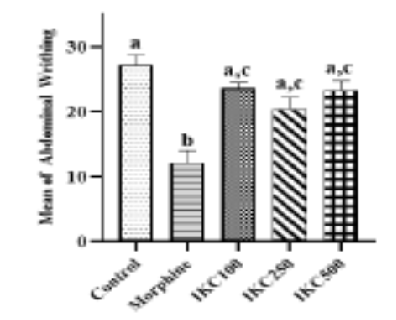


Indian Journal of Science and Technology
DOI: 10.17485/IJST/v16sp1.msc6
Year: 2023, Volume: 16, Issue: Special Issue 1, Pages: 39-47
Original Article
Charles Lalnunfela1, H T Lalremsanga1, K Lalchhandama2, P B Lalthanpuii2, C Lalmuanthanga3, T C Lalhriatpuii4*
1Department of Zoology, Mizoram University, Tanhril, 796004, Mizoram, India
2Department of Life Sciences, Pachhunga University College, Aizawl, 796001, Mizoram, India
3Department of Pharmacology & Toxicology, College of Veterinary Sciences & Animal Husbandry, Central Agriculture University, Aizawl, 796014, Mizoram, India
4Department of Pharmacy, Regional Institute of Paramedical and Nursing Sciences, Zemabawk, 796017, Mizoram, India
*Corresponding Author
Email: [email protected]
Received Date:23 January 2023, Accepted Date:09 June 2023, Published Date:30 July 2023
Objective: To evaluate the analgesic and anti-inflammatory properties of I. khasiana using selected parameters. Methods: Acetic acid induced writhing test, Tail emersion test and Hot plate test, Xylene induced ear edema, Formalin induced paw edema and Carrageenan induced paw edema were employed for the studies of anti-inflammatory activity of the plant on Swiss albino mice. Findings: In the acetic acid induced abdominal writhing test, the highest percent of inhibition 30.95% was found in 250 mg.kg b.w dose of IKM followed by 25.50% in IKC. In tail emersion test highest analgesic percentage was found at 90 minutes in IKC (250 mg.kg b.w) 68.96, but IKM (250 mg.kg b.w) exhibited the highest inhibition of 50% at 120 minutes. Surprisingly, IKC (500 mg.kg b.w) at 180 minutes gave the highest inhibition percentage of 76.19 but IKM (250 mg.kg b.w) at 180 minutes inhibited 79.36% of the pain which was slightly higher when compared to 60.60% of IKM (500 mg.kg b.w) at the same time point. In xylene induced ear edema test IKM gave 36.84% of inhibition and it was higher than IKC (500 mg/kg b.w) which was found to be 24.73. After 6 hours in formalin induced edema, IKC (250 mg/kg b.w) gave 49.69% of inhibition which was higher than 36.21% inhibition exerted by IKM. In both the paw edema test, at 2 hours after inducing inflammation, the peak was comparatively high and reduced gradually as the time increased. Carrageenan paw edema was measured for 6 hours at hourly intervals. Inhibition of edema increased with time, IKM (250 mg/kg b.w) has a percentage of 36.21% and IKC at the same dose has 28.16% of inhibition. Novelty: Ilex khasiana, the unexplored yet critically endangered species has a scientific support not only with regards to its protection but its enormous contribution in phytochemistry. Conclusion: IKC and IKM showed close efficacy regarding their analgesic and anti-inflammatory activity. Like the other Ilex species, I. khasiana has valuable medicinal property and is demanding special attention being a critically endangered species in terms of propagationand protection.
Keywords: Ilex Khasiana; Analgesic; Antiinflamatory; IKM; IKC
© 2023 Lalnunfela et al. This is an open-access article distributed under the terms of the Creative Commons Attribution License, which permits unrestricted use, distribution, and reproduction in any medium, provided the original author and source are credited. Published By Indian Society for Education and Environment (iSee)
Subscribe now for latest articles and news.